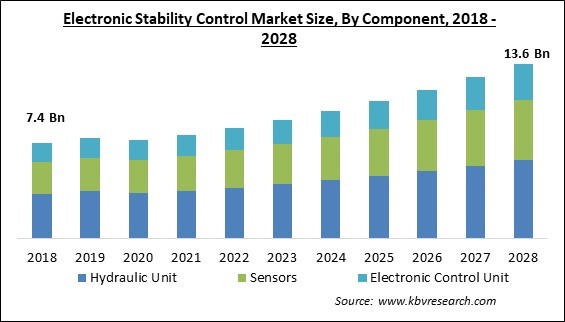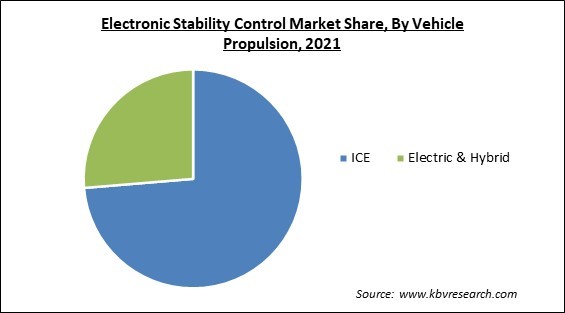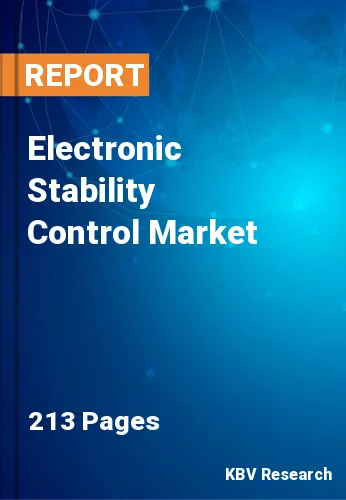The Global Electronic Stability Control Market size is expected to reach $13.6 billion by 2028, rising at a market growth of 8.0% CAGR during the forecast period.
Automobiles, coaches, buses, and lorries can all be equipped with electronic stability control (ESC), commonly called the electronic stability program. The system, which includes a speed sensor and autonomous brakes for each wheel, is an expansion of antilock braking technology. In diverse driving circumstances, the main goal of ESC is to avoid vehicle skidding. To stop the car from sliding, the system recognizes hazardous driving situations and provides a specified amount of brake pressure to one or more wheels.

In addition, the ESC also automatically modifies the torque during a crucial driving condition to keep the driver in control of the steering. The ESC automatically applies the brakes to assist in steering the car in the direction the driver desires to travel when it senses a lack of steering control. The outer front wheel is automatically braked to oppose oversteer, while the inner rear wheel is automatically braked to counter understeer. Some ESC systems may reduce engine power while waiting for control to return. Instead of enhancing a vehicle's cornering capability, ESC works to lessen the likelihood that the driver may lose control of the car.
Only when there is a likely loss of steering control, such as when the car deviates from the driver's intended course, does the ESC step in. This may occur, for instance, during hydroplaning, understeering, or oversteering during poorly assessed maneuvers on slick roads, or sliding during emergency evasive swerves. Since steering input doesn't always indicate the desired direction of travel while driving at high speeds, ESC may interfere when it's not wanted. To oppose the skid and bring the car back in line with the driver's requested direction, ESC first determines the direction of the skid and then applies the brakes asymmetrically to certain wheels. The system may also lower engine power or engage the transmission to slow the car down.
Most industry sectors globally have seen a significant effect due to the pandemic. In addition to affecting public health issues, it significantly disrupted financial or industrial activity. Some countries enacted partial or total lockdowns to stop the disease's spread. Also, COVID-19 is still affecting the automobile sector. The industry's supply chain has been hampered by several laws and regulations that the government has implemented, including limitations on import-export activity, travel and transportation restrictions, etc. As a result, the automotive sector has been negatively impacted due to the sharp fall in demand for automobiles, auto components, and other factors. Hence, the market for electronic stability control is projected to experience a rise in growth rate during the projected period as the world economy gets back on track.
The electronic stability control market expansion potential is expected to be highly profitable as autonomous mobility develops and gains popularity. Furthermore, safety is a major selling point for autonomous vehicles. Hence, the demand for better safety features in these vehicles positively affects the market growth. Moreover, level 5 vehicles must be fitted with various safety systems, including ADAS, ESC, and others, to produce fully autonomous vehicles. The usage of the electronic stability control in the next years is anticipated to increase as automakers are raising their investments in R&D efforts to produce fully autonomous cars.
Automakers are developing and delivering safety features to meet consumer demand. Thus, the market for electronic stability control is expanding due to the rising demand for safety features. The utilization of electronic stability control systems is expected to grow due to the demand for advanced safety features such as electronic control systems and anti-lock braking systems in automobiles. Also, with the increasing public awareness of the need for road safety combined with a significant uptick in deploying advanced driver assist systems in automobiles, the market expansion will surge.
Drivers shouldn't regard this functionality as improving performance. While ESC makes turning more manageable, this function can't make corners quicker because it can't enhance traction. Furthermore, high-Performance Driving is incompatible with ESC, which may interfere while driving at high speed. Because the steering input doesn't always recognize the desired direction during controlled drifting, unwanted ESC applications can occur. As high-performance driving can make ESC incompatible, joined with its other issues, the need for better alternatives might arise, which is expected to hamper the electronic stability control market's growth in the projected period.
Based on component, the electronic stability control market is segmented into hydraulic unit, sensors, and electronic control unit. The hydraulic unit segment held the highest revenue share in the electronic stability control market in 2021. This is due to the presence of shift valves for the individual wheel brakes in the hydraulic unit, which is required to manage brake pressure. They are employed in the hydraulic unit to regulate the three pressure states that call for regulation: increasing pressure, maintaining pressure and decreasing pressure. Also, the hydraulic unit often has the control unit for driving dynamics and braking.

On the basis of vehicle type, the electronic stability control market is divided into passenger cars, light commercial vehicles and heavy commercial vehicles. The passenger cars segment witnessed the largest revenue share in the electronic stability control market in 2021. The growth is attributed to the growing demand for high-end passenger cars with cutting-edge safety features. Government laws and regulations require the use of ESC in passenger vehicles. Many automakers are producing passenger cars with ESC systems already installed. Some mid-range automakers want to add ESC to their passenger vehicles in response to the growing number of safety rules.
By vehicle propulsion, the electronic stability control market is classified into ICE and electric & hybrid. The electric & hybrid segment garnered a prominent revenue share in the electronic stability control market in 2021. This is because commercially available electric-drive cars are subject to the same stringent safety testing as conventional vehicles offered in many nations and are required to fulfill the Safety Standards in accordance with the nation they are being sold. Also, EVs are generally equipped with the most high-tech features to provide ease in driving and make the vehicle safer for the passengers. These factors are anticipated to drive the segment's growth in the projected period.
| Report Attribute | Details |
|---|---|
| Market size value in 2021 | USD 8 Billion |
| Market size forecast in 2028 | USD 13.6 Billion |
| Base Year | 2021 |
| Historical Period | 2018 to 2020 |
| Forecast Period | 2022 to 2028 |
| Revenue Growth Rate | CAGR of 8% from 2022 to 2028 |
| Number of Pages | 213 |
| Number of Table | 340 |
| Report coverage | Market Trends, Revenue Estimation and Forecast, Segmentation Analysis, Regional and Country Breakdown, Companies Strategic Developments, Company Profiling |
| Segments covered | Component, Vehicle Propulsion, Vehicle Type, Region |
| Country scope | US, Canada, Mexico, Germany, UK, France, Russia, Spain, Italy, China, Japan, India, South Korea, Singapore, Malaysia, Brazil, Argentina, UAE, Saudi Arabia, South Africa, Nigeria |
| Growth Drivers |
|
| Restraints |
|
Region-wise, the electronic stability control market is analyzed across North America, Europe, Asia Pacific, and LAMEA. The Asia Pacific region led the electronic stability control market by generating the maximum revenue share in 2021. This is because of the vehicle production and sales growth in the area. Asia Pacific is predicted to account for many automotive electronic stability control systems. There is an increasing adoption rate of advanced driving assistance systems in many Asian nations. Moreover, it is projected that factors including rising consumer disposable income and rising demand for luxury automobiles would boost the market growth in the region.
Free Valuable Insights: Global Electronic Stability Control Market size to reach USD 13.6 Billion by 2028
The market research report covers the analysis of key stake holders of the market. Key companies profiled in the report include Robert Bosch GmbH, Continental AG, Johnson Electric Holdings Limited, Aisin Corporation (Toyota Motor Corporation), Valeo SA, Murata Manufacturing Co., Ltd., Hitachi, Ltd., Knorr-Bremse AG, ZF Friedrichshafen AG (TRW), and Mando Corporation (Halla Group).
By Component
By Vehicle Propulsion
By Vehicle Type
By Geography
The global Electronic Stability Control Market size is expected to reach $13.6 billion by 2028.
Growing adoption of autonomous mobility are driving the market in coming years, however, Issues with electronic stability control system restraints the growth of the market.
Robert Bosch GmbH, Continental AG, Johnson Electric Holdings Limited, Aisin Corporation (Toyota Motor Corporation), Valeo SA, Murata Manufacturing Co., Ltd., Hitachi, Ltd., Knorr-Bremse AG, ZF Friedrichshafen AG (TRW), and Mando Corporation (Halla Group).
The expected CAGR of the Electronic Stability Control Market is 8.0% from 2022 to 2028.
The ICE segment acquired maximum revenue share in the Global Electronic Stability Control Market by Vehicle Propulsion in 2021 thereby, achieving a market value of $9.5 billion by 2028.
The Asia Pacific market dominated the Global Electronic Stability Control Market by Region in 2021, and would continue to be a dominant market till 2028; thereby, achieving a market value of $5 billion by 2028.
Our team of dedicated experts can provide you with attractive expansion opportunities for your business.

